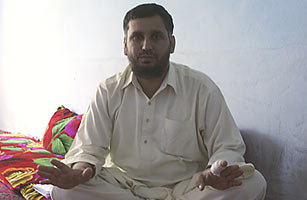By Jason Motlagh

Afghan journalist Tahir Ludin, who was held captive with New York Times reporter David Rohde, at his home in Kabul on June 22, 2009. Photo: Rahim Faiez / AP
The escape of veteran New York Times correspondent David Rohde from Taliban captors was a rare piece of good news from the Afghan-Pakistan borderlands. For more than seven months, there was almost no public word on his fate. Western news agencies kept silent about the kidnapping of the Pulitzer Prize–winning journalist, the Afghan reporter Tahir Ludin and their driver, out of concern that international attention might jeopardize their safety. The trio was betrayed by a Taliban commander with whom Ludin had arranged meetings several times before. It was yet another reminder of the dangerous unpredictability of reporting the Afghan war. With negotiations for their release at a stalemate, Rohde and Ludin jumped the wall of the compound where they were being held, in North Waziristan, while guards were asleep.
While abductions of foreign journalists can end and have ended in tragedy, the risks facing Afghan journalists are even greater. The Taliban and other lawless elements in the country are often motivated by the potential ransoms — sometimes worth several million dollars — they believe foreigners can bring them. Afghan journalists who fall into their hands generally do not offer the same moneymaking possibilities. And so the escape of Ludin, who like some other local journalists acts as a "fixer" for foreign correspondents, was particularly welcome.
Most Afghan reporters know the prevailing reality. "We know that the chances are greater we might be killed if we are taken by the Taliban," says an Afghan photographer working part time for a Western news agency. He and his local colleagues trust that their employers will support them "to a point," he says, but they accept that insurgents are likely to punish them as "traitors" for working with foreigners, absent the prospect of a hefty ransom. "They won't think too much about what to do with us. That's something we have to accept," says the photographer. (Ransom does not appear to have been a factor in Rohde's case, and the Canadian Broadcasting Corp. denies that it paid a ransom to effect the release of its reporter Melissa Fung in November 2008.)
The killing of Ajmal Nakshbandi provides a grim counterpoint to the Rohde story. In May 2007, the freelance Afghan journalist and translator was accused of being a spy, abducted and beheaded by the Taliban in southern Helmand province. The Italian correspondent he was working with, Daniele Mastrogiacomo, was later released in exchange for five militants and an undisclosed sum of cash paid by the Italian government. Another Afghan reporter working in Helmand, Abdul Samad Rohani, was killed last June while investigating a story for the British Broadcasting Corp. on illegal poppy cultivation. The Taliban, usually quick to claim credit even in instances where they may not actually be involved, denied any role in his death. Afghan journalists and human-rights watchers allege that he was slain by gunmen with links to the drug trade.
The danger does not only come from drug lords and the Taliban. Afghan journalists say their government is not making reporting any easier. Islamic hard liners, former warlords and corrupt officials, they explain, are behind an increasingly harsh assault on press freedom — one of the country's key post-Taliban achievements — that has spawned an increasing amount of self-censorship. A recent report by the Afghan Independent Journalists' Association said that over the past year, 25 journalists were arrested, 24 were beaten or intimidated by public officials, 22 received death threats and four outlets were forced to close. Rahimullah Samandar, head of the association, says religion, official graft and certain issues related to national security are now seen as "red lines," crossed at one's peril.
Two al-Jazeera journalists, Qais Azimy and Hameedullah Shah, were released on Wednesday after being held incommunicado by Afghanistan's intelligence service for three nights on grounds that they were a "threat to the internal security of the country." The evidence: a June 11 report produced by Azimy in which a Taliban commander in Kunduz province boasted that he has hundreds of fighters and a dozen suicide bombers ready to strike. The Qatar-based TV network insists the story was balanced by an interview with a German coalition officer. Questioned by one of its staff at a press conference, President Hamid Karzai countered that the story was "not a case of press [freedom] — it was a case of making a story in favor of terrorism."
Meanwhile, as dramatic as Rohde's escape was, the story is not yet complete. The young Afghan driver, Asadullah Mangal, who drove Rohde and Ludin to the unlucky assignment, was apparently too afraid to make a break. Now he is alone. If local journalists have little market value for the Taliban, how much will the group value a driver?



